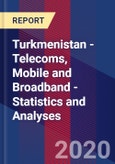Turkmenistan collaborating on Trans-Caspian cable.Market Penetration Reached 122% in 2015
Slow growth in telecom services in Turkmenistan, a predominantly rural country and former Soviet republic, can be attributed to a large extent to the slow development of the private sector and state control over most economic activities.
Turkmentelecom is the primary provider of telecom services. Mobile services are offered through its subsidiary TM-Cell. There was some competition from MTS Turkmenistan before that private company withdrew from the market in late 2019, having had its operating licence revoked.
The mobile market experienced extraordinarily growth between 2007 and 2012, though growth since then has slowed considerably. While market penetration is relatively high, the monopoly held by TM Cell is not conducive to encouraging reduced pricing for end-users, of improved quality of service, or of upgraded network capacity.
Turkmenistan has experienced a number of problems in its efforts to upgrade telecom infrastructure, and the telephone network remains poorly developed. Many rural areas have no fixed-line coverage, leaving the relatively antiquated mobile network infrastructure as the only platform for voice and data services.
Fixed broadband penetration in Turkmenistan remains limited in scale and nature. Services are extremely slow, though when the Trans-Caspian cable is completed the country will secure additional international internet capacity which should see an improvement in the quality of services.
The publisher notes that the outbreak of the Coronavirus in 2020 is having a significant impact on production and supply chains globally. During the coming year the telecoms sector to various degrees is likely to experience a downturn in mobile device production, while it may also be difficult for network operators to manage workflows when maintaining and upgrading existing infrastructure. Overall progress towards 5G may be postponed or slowed down in some countries.
On the consumer side, spending on telecoms services and devices is under pressure from the financial effect of large-scale job losses and the consequent restriction on disposable incomes. However, the crucial nature of telecom services, both for general communication as well as a tool for home-working, will offset such pressures. In many markets the net effect should be a steady though reduced increased in subscriber growth.
Although it is challenging to predict and interpret the long-term impacts of the crisis as it develops, these have been acknowledged in the industry forecasts contained in this report.
The report also covers the responses of the telecom operators as well as government agencies and regulators as they react to the crisis to ensure that citizens can continue to make optimum use of telecom services. This can be reflected in subsidy schemes and the promotion of tele-health and tele-education, among other solutions.
Key developments:
- MTS exits from Turkmenistan;
- Caspian Sea cable between Azerbaijan and Turkmenistan gains approval;
- Fixed broadband penetration in Turkmenistan remains limited in scale and nature and extremely low;
The report update includes an assessment of the global impact of COVID-19 on the telecoms sector, recent market developments.
Table of Contents
1 Key statistics2 Regional Asian Market Comparison12 Appendix Historic data13 Glossary of abbreviations14 Related reports
3 Country overview
4 COVID-19 and its impact on the telecom sector
5 Telecommunications market
6 Regulatory environment
7 Mobile market
8 Fixed-line broadband market
9 Digital Economy
10 Fixed network operators
11 Telecommunications infrastructure
List of Tables
List of Charts
List of Exhibits








